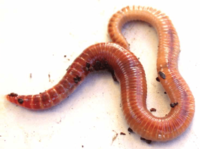Red wiggler worms
Overview
Red wiggler worms, scientifically known as Eisenia fetida, are classified as Annelids. They go by various other common names such as the manure worm, dung worm, tiger worm, etc. They are widely known for their use in compost[3].
Classification

Domain: Eukarya
Kingdom: Animalia
Phylum: Annelida
Class: Oligochaeta
Order: Hapliotaxida
Family: Lumbricidae
Genus: Eisenia
Species: Eisenia Fetida
Habitat
Red wiggler worms are Epigeic Earthworms , meaning they live on the upper surface of the soil or in the soil litter[3]. Red wiggler worms prefer moist, organic-rich environments[5]. Manure or compost provides a great environment for them. The species originated from Europe, but because it is a commercial species and used as fish bait and in vermicomposting, it can be found all across the world[3].
Life Cycle and Reproduction

Venter and Reinecke (1988) found that, in favorable conditions, red wiggler worms have a better reproductive ability than other composting worms, so using these worms in vermicomposting will produce a faster working compost. After four days of mating, a cocoon forms where hatchlings will emerge from after an average of 23 days. Usually 2-3 hatchlings are produced, however sometimes more. After around 40-60 days hatchlings mature and reproduce[4]. Red wiggler worms, as well as all earthworms, are hermaphroditic, but no self-fertilization has been documented. Juvenile red wiggler worms do not yet have a clitellum that is used in reproduction[3].
References
[1]Edwards, C. A., and N. Q. Arancon. (n.d.). THE SCIENCE OF VERMICULTURE: THE USE OF EARTHWORMS IN ORGANIC WASTE MANAGEMENT:25.
[2]Eisenia andrei specimen during the experiment. Credit: photo courtesy... | Download Scientific Diagram. (n.d.). . https://www.researchgate.net/figure/Eisenia-andrei-specimen-during-the-experiment-Credit-photo-courtesy-of-Elaine-van-Ommen_fig1_265518697.
[3]UWL Website. (n.d.). . http://bioweb.uwlax.edu/bio203/2010/yard_jose/habitat.htm.
[4]Venter, J. M., and A. J. Reinecke. 1988. The life-cycle of the compost worm Eisenia fetida (Oligochaeta). South African Journal of Zoology 23:161–165.
[5]Wormy FACTS and Interesting Tidbits (By Rhonda Sherman). (n.d.). . https://composting.ces.ncsu.edu/vermicomposting-2/wormy-facts-and-interesting-tidbits/.